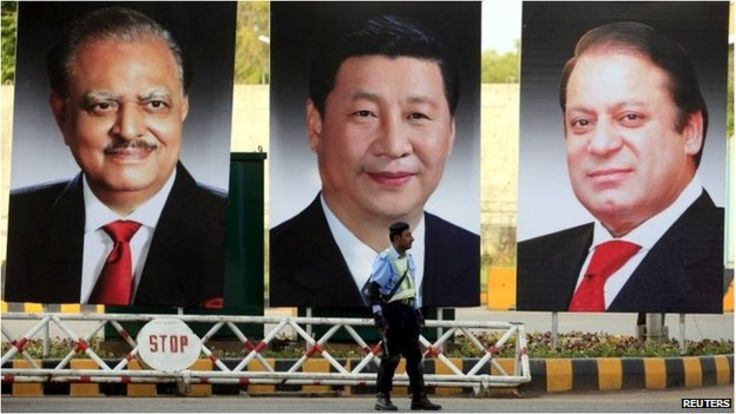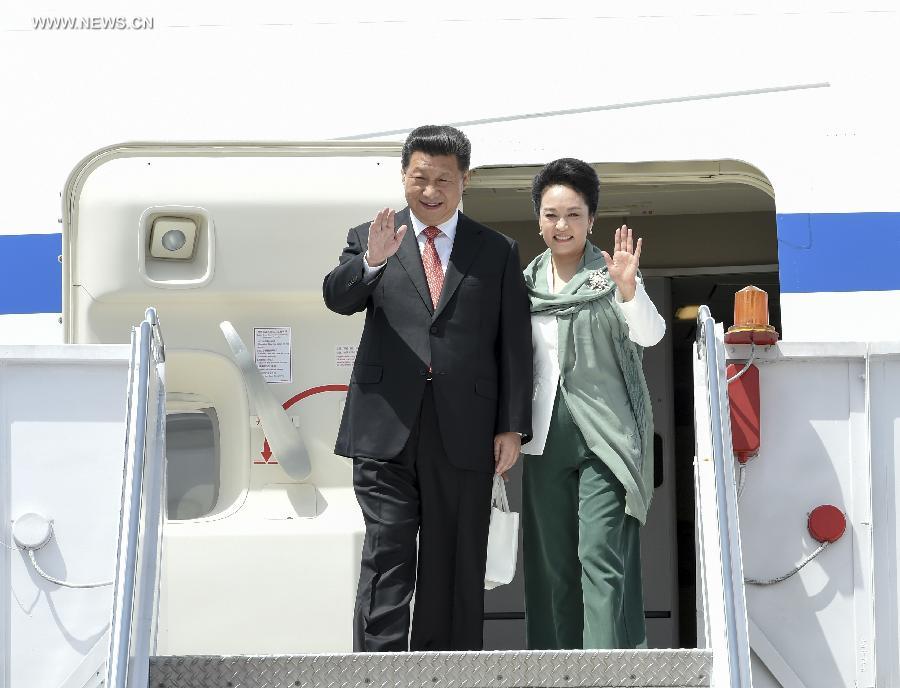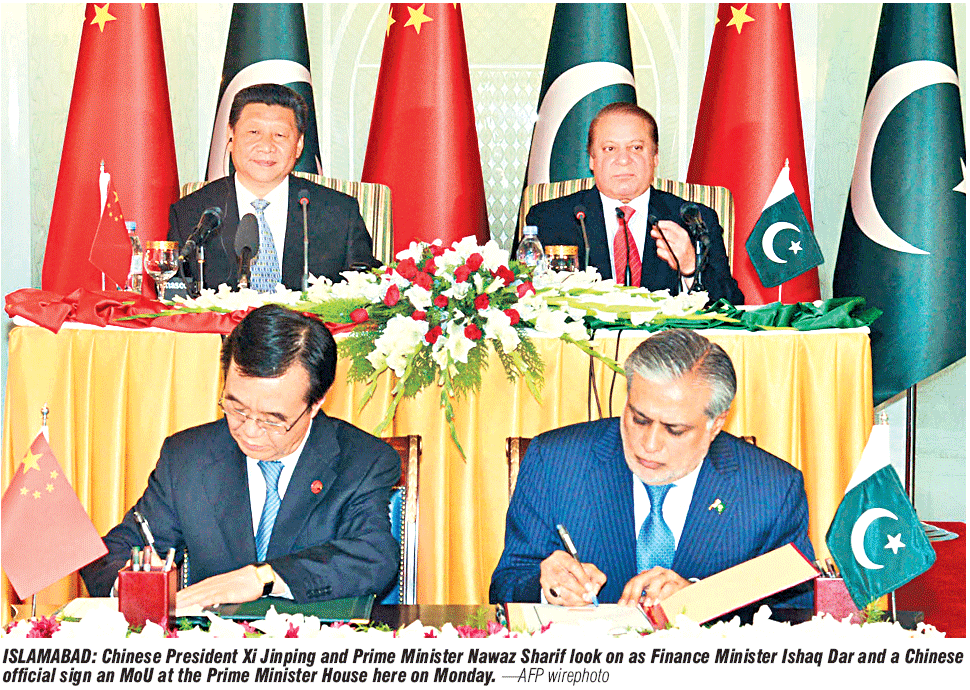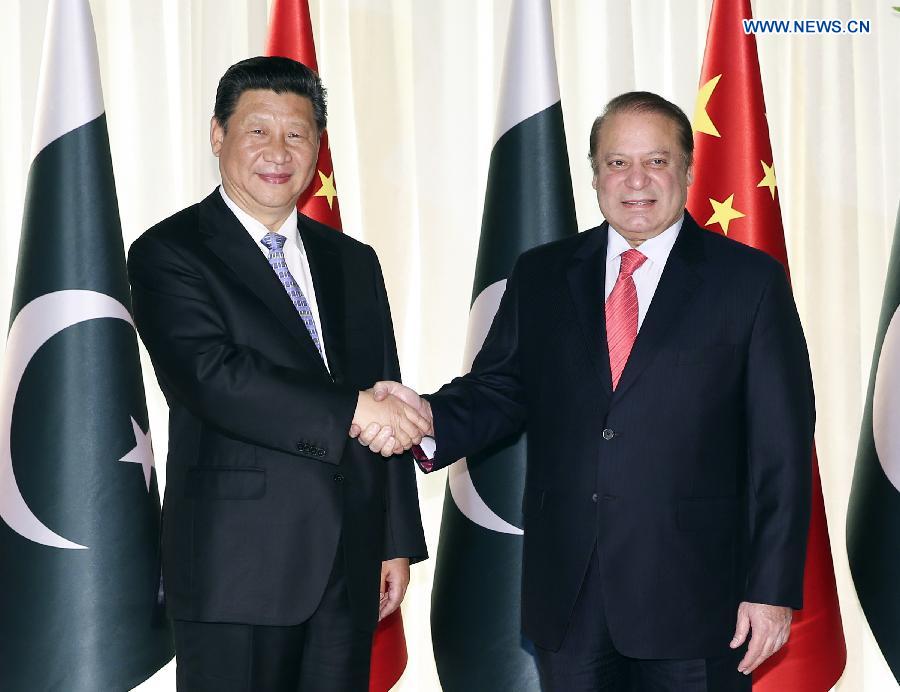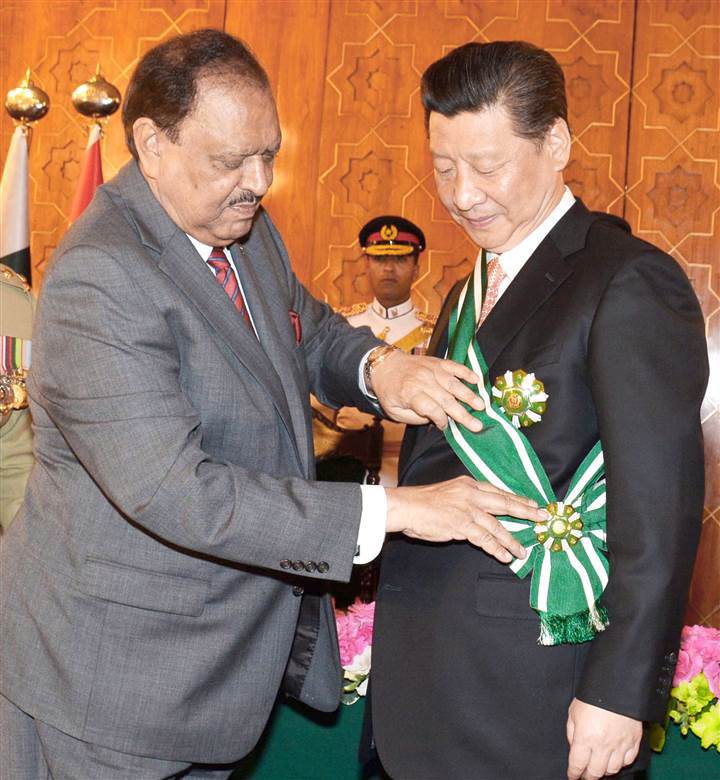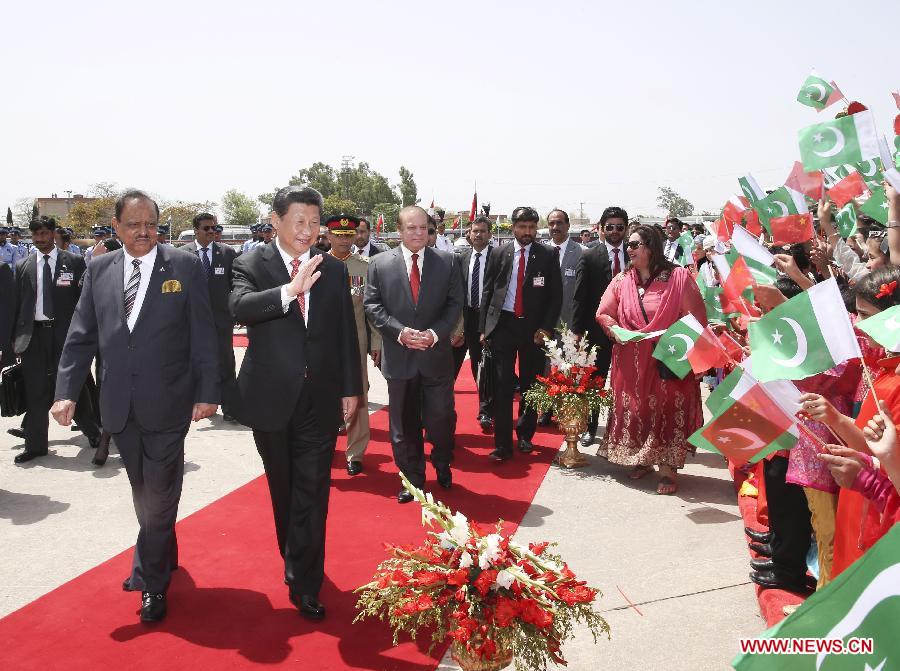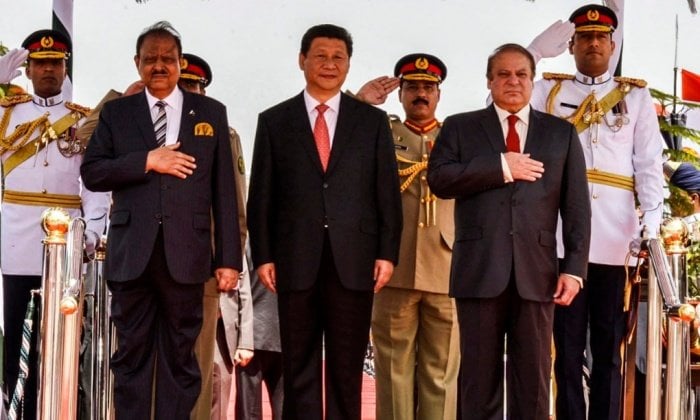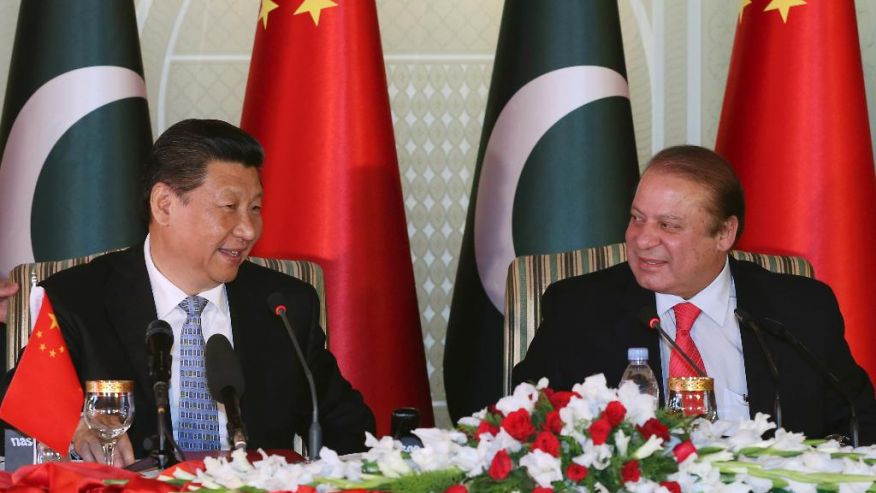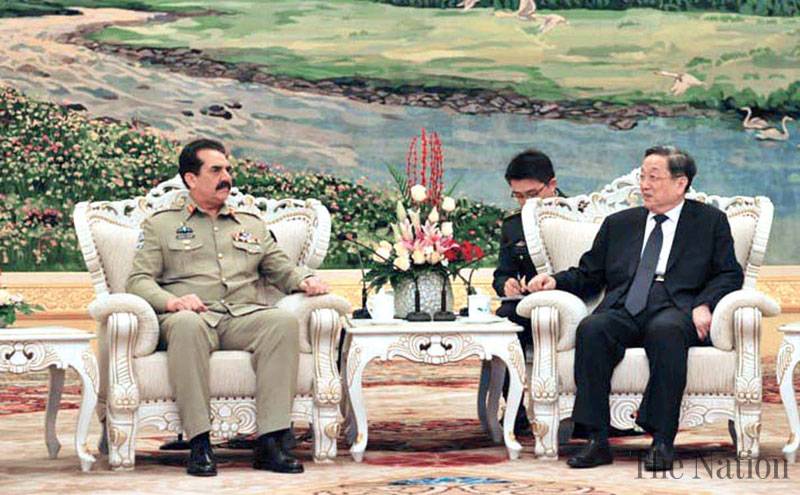Mehmood Ul Hassan Khan
Economics of Pak-China Friendship is unique and has strategic importance. It has multidimensional aspects and does not confined to better political understanding and sharing of similarities on different regional and international issues. It covers all aspects of human survival and industrial production. It ranges from close economic cooperation to massive foreign direct investments, joint ventures and transfers of technologies. It has direct correlation in many fields of economic cooperation. It provides win-win situation to both the sides. Moreover, Chinese high valued “economic corridor” project and “One Belt, One Road (OBOR)” is a paradigm of regional co-existence.
Fate-Changing Visit of Chinese President
Long awaited official visit of Chinese President Xi Jinping concluded with singing of 51 pacts, including 30 accords pertaining to Economic Corridor. China promised to expand civil-nuclear cooperation. It was paradigm shift in Pak-China bilateral relations. Both the countries agreed to raise their trade volume up to $20 billion. It was indeed a fate-changing visit. Pakistan and China rolled out a $45 billion portfolio agreed under the China-Pakistan Economic Corridor (CPEC).
The long-delayed historic and landmark visit of Chinese President Xi Jinping has made a cherished dream about massive development of infrastructure, energy and communication projects especially the flagship China-Pakistan Economic Corridor (CPEC) come true.
It is hoped that the landmark visit of Chinese President Xi Jinping would usher in a new era of development in Pakistan and start a new chapter in the friendship between the two countries. Pakistan attached the highest priority to its strategic cooperative partnership with China.
The Gwadar Port Project is the centre piece of Pak-China strategic partnership with its strategic location and potential for becoming the future economic and energy hub. Cluster of projects finalized during the recently concluded visit of Chinese President will transform it into one of the world’s leading port cities having top-class commercial and tourist facilities, integrated infrastructure and investment opportunities. It will make Gwadar a catalyst for development of the Makran Coast and Balochistan in particular, and Pakistan in general.
Signed Agreements Worth Nature
$28 billion Immediately kick-start early harvest projects
$17 billion These are in the pipeline and will follow as soon as the required studies, processes and formalities are completed.
Source: Different English Dailies of Pakistan & China
Both countries had also finalised plans to add 10,400MW of electricity capacity through early harvest energy generation projects spread all across the country to be completed by 2017/18, and another 6,645MW of projects for energy on the actively promoted list. All energy projects will be on commercial basis in investment mode. After completing all the requisite regulatory and other facilitation requirements the two sides have concluded financial close for 200MW wind power projects, 5,580MW of coal-based power generation projects, 1,590MW hydro power project, 1,000MW solar project and 3.8MTPA coal mining project during visit of Chinese president.
Significance Financial Agreements
The groundbreaking and signing of financial agreements has demonstrated that there is a strong will on both sides to implement the portfolio of $45 billion agreed under the CPEC framework as early as possible to help Pakistan meet its energy needs. The agreements and MOUs signed are as under:
Table-I
Nature/Type Details
Economic & Technical Economic and technical cooperation agreement between China and Pakistan.
Exchange of Notes
Exchange of Notes of Feasibility Study Exchange of notes of feasibility study of the demonstration project of the DTMB.
Exchange of Notes Exchange of notes on provision of anti-narcotics equipment.
Exchange of Notes Exchange of notes on provision of law enforcement equipment.
Exchange of Notes Exchange of notes on feasibility study of Gwadar hospital
The Table-I shows that “Exchange of Notes” cover diversified aspects of greater economic integration which would hopefully accelerate the technical cooperation in the days to come. It also shows the commitments of both sides to cope with the menace of terrorism.
Table-II
Nature/Type Details
MOUS
Karakorum Highway (Havelian to Thakot) Provision of Chinese governmental concessional loan for second phase up-gradation of the Karakorum Highway (Havelian to Thakot).
Karachi-Lahore Motorway (Multan to Sukkur) Provision of Chinese governmental concessional loan for Karachi-Lahore Motorway (Multan to Sukkur).
Gwadar port East Bay Expressway Project Provision of Chinese governmental concessional loan for Gwadar port East Bay Expressway Project.
Gwadar International Airport Provision of Chinese governmental concessional loan for Gwadar international airport.
Climate Change Provision of material for tackling climate change.
NDRC of China and Ministry of Planning Development and Reform of Pakistan Cooperation between NDRC of China and Ministry of Planning Development and Reform of Pakistan.
Port of Gwadar Region Pro Bono Projects in the Port of Gwadar Region.
Joint Cotton bio-tech laboratory Establishment of China-Pakistan joint cotton bio-tech laboratory.
Communications Cooperation between the State Administration of Press, Publication, Radio, Films and Television of China and Ministry of Information, Broadcasting and National Heritage of Pakistan.
Gwadar East bay expressway Financing for KKH up-gradation Phase-2 (Havelian to Takot), KLM, Gwadar east bay expressway, Gwadar international airport projects
Wapda and CTG Cooperation between Wapda and CTG.
Private Hydro Power Projects Cooperation among PPIB, CTG, and Silk Road Fund on Development of Private Hydro Power Projects.
Educational Cooperation NUML Pakistan and Xinjiang Normal University, Urumqi China for Cooperation on Higher Education
Source: Different English Dailies of Pakistan & China
The Table-II indicates the importance of different MOUs signed during the visit of Chinese President Xi Jinping which covers the further development of Gwadar region, airport, infrastructures, agriculture cooperation, and the last but not the least, educational cooperation between the two sides.
Table-III
Nature/Type Details
Protocols
Banking Services Banking services to agreement on trade in services
Research Center Establishment of China-Pakistan joint marine research center.
Sister Cities Relationship Establishment of sister cities relationship between Chengdu city Sichuan Province of PRC and Lahore city.
Sister Cities Relationship Establishment of sister cities Relationship between Zhuhai city, Guangdong province and Gwadar city.
Sister Cities Relationship Establishment of sister cities relationship between Karamay City, XianjianUgur, and Gwadar city.
Source: Different English Dailies of Pakistan & China
The Table-III clearly indicates that extended bilateral cooperation in the fields of banking, trade services and the last but not the least, metropolitan cooperation would further speed-up the economic integration in the days to come.
Table-IV
Nature/Type Details
Framework Agreements
Energy Strategic Cooperation Punjab province and China Huaneng Group.
Communications Infrastructure Cooperation on major communications infrastructure project
Economic Corridor Energy Project Cooperation Establishment of he China Pakistan Economic Corridor Energy Project Cooperation.
Joint Feasibility Study National Railway Administration, China and the Ministry of Railways, Pakistan on joint feasibility study for up-gradation of ML1 and establishment of Havelain dry port of Pakistan Railways.
LNG terminal and pipeline project NEA and MoPNR on Gwadar-Nawabshah LNG terminal and pipeline project.
Implementation of the China-Pakistan Economic Corridor China Development Corporation and HBL
Chinese investments Promotion of Chinese investments and industrial parks development in Pakistan between ICBC and HBL on financial services corporation.
Banking Cooperation 720MW Karot hydropower project between China Development Bank Corporation, EXIM Bank of China and Karot Power Company (Private) Limited.
Source: Different English Dailies of Pakistan & China
The Table-IV summarizes the framework agreements executed during the historic visit of Chinese President. It has multidimensional orientation which covers all aspects of infrastructural development in the fields of ports, railways, banking and communication sectors.
Economic Corridor would cater to all federating units through extensive rail and road network and multiple projects in energy sector. It comprises modern highway and railway transportation system; linking Kashgar in West China, to Khunjrab in the north and onwards to Karachi and Gwadar in the south of Pakistan through multiple routes. According to official figures the corridor projects initially envisage $34 billion investment in energy sector and around $11 billion in infrastructure sector.
It is hoped that the provincial capitals, Quetta, Peshawar, Karachi and Lahore would be center of attraction whilst less-developed regions of the country including Fata, KP, AJK, Gilgit-Baltistan, South Punjab, Thar in interior Sindh and Gwadar in Balochistan, will also be brought into the folds of active development.
Table-V
Nature/Type Details
Financing Agreement
Hydropower Project 870MW hydro-electric Suki Kinari hydropower project between EXIM Bank of China, Industrial and Commercial Bank of China Limited and SK Hydro (Private) Limited.
Coal-fired Power Plant EXIM Bank of China and Port Qasim Electric Power Company (Private) Limited (on Port Qasim 2x660MW coal-fired power plant).
Thar Block –I The development of Thar Block –I between ICBC, SSRL.
Wind Power Dawood Wind Power project between ICBC and PCC of China and HDPPL.
Orange line Metro Train It is for the completion of Lahore Orange line Metro Train project
Source: Different English Dailies of Pakistan & China
The Table-V signifies Pak-China extended and diversified energy cooperation which would be a fate-changer for our economy, civility and industrial production in the days to come. It is crystal clear that energy sector has been assigned top priority to help Pakistan overcome energy shortages in order to achieve higher growth rates for speedy development.
Table-VI
Nature/Type Details
Facility Agreement
Coal-fired Power Plant Sahiwal Coal-fired Power Plant Project between industrial and Commercial Bank of China Limited, Huaneng Shandong Electricity limited and Shandong Ruyi Group.
Coal-fired Power Project Salt Range Coal-fired Power Project between CMEC and Punjab Government.
The above given Table-VI upholds the importance of diversified energy cooperation between Pakistan and China. Renewables like coal is making inroad in the energy mix of Pakistan.
Table-VII
Nature/Type Details
Terms & Conditions
Solar Project Zonergy 9×100 MW solar project in Punjab between China Development Bank Corporation, EXIM Bank of China and Zonergy Company limited.
Thar Block II Sindh Engro Coal Mining Company for Thar Block II 3.8Mt/a mining Project, Sindh province, Pakistan arranged by China Development Bank Corporation.
Thar Block II Engro Powergen Thar (Private) Limited, Sindh province, Pakistan for Thar Block II 2x330MW coal fired power project arranged by China Development Bank Corporation.
Source: Different English Dailies of Pakistan & China
Table-VII reflects that energy cooperation is the way forward for both the countries. Pakistan badly needs energy and China has professional expertise. Combination of both would create wonders in the days to come.
Table-VIII
Nature/Type Details
Different Agreements
Drawdown Agreement Jhimpir wind power project between UEP Wind Power (Private) Limited as borrower and China Development Bank Corporation as lender.
IA Port Qasim Coal fired Power Plant between Power China and GoP.
Triple Party Agreement China Central Television and PTV and Pakistan Television Foundation on the re-broadcasting of CCTV-NEWS/CCTV -9 Documentary in Pakistan.
Source: Different English Dailies of Pakistan & China
Table-VIII also verifies the importance of extended energy cooperation between the two sides. Different agreements in the fields of coal power generation would create healthy impact on our economy and production in the days to come.
Table-VIV
Nature/Type Details
Cooperation Agreement
Wind Power Project Sino-Sindh Resources (Pvt) Ltd and Shanghai Electric Group for Thar Coalfield Block I Coal-Power integrated Project in Pakistan.
Coal-fired Power Plant Hubco Coal-fired Power Plant Project between CPIH and Hubco Power Company.
Transmission Matiyari-Lahore and Matyari (Port Qasim)-Faisalabad Transmission and Transformation Project between National Transmission Distribution Company (NTDC) and National Grid of China.
International Center of Education Establishment of NUML International Center of education (NICE) between NUML Pakistan and Xinjiang Normal University, Urumqi, China.
Source: Different English Dailies of Pakistan & China
The above table strengthens the power sector and its different interconnected fields such as transmission and supplies etc.
Inaugurations
During the valuable visit the two leaders inaugurated the following projects by unveiling the plaques:
i. Industrial and Commercial Bank of China, Lahore Branch.
ii. Energization of 100 MW solar power plants at Quad-i-Azam solar park, Bahawalpur.
iii. FM 98 Dosti Channel studio PBC-CRI, Islamabad.
iv. Demonstration project of DTMB Broadcasting in Pakistan.
v. China Cultural center Pakistan.
vi. China-Pakistan Joint Research Center for small hydropower, Islamabad.
vii. China-pakistan cross-border optical fiber cable system project.
viii. Metro rail transit system on the Orange Line in Lahore.
Ground Breaking
Both leaders jointly done the ground breaking ceremony of the following projects:-
i. Karot 720 MW Hydropower project.
ii. Dawood 50 MW Wind-power project.
iii. Sachal 50 MW Wind-power project.
iv. Zonergy 900 MW solar project.
v. Jhimpir 100 MW Wind-power project.
Chinese President Xi Jinping
The President of China said the Operation Zarb-e-Azb initiated by Pakistan would bring peace and economic stability in the country and expressed the resolve to extend all-out cooperation in the fight against terrorism.
President Xi Jinping appreciated Pakistan’s efforts for peaceful co-existence with its neighbouring countries and appreciated Pakistan’s constructive role to help Afghanistan achieve peace and stability.
The President of China, Xi Jinping, said 30 of these agreements were related to the China Pakistan Economic Corridor and highlighted the few that included the Gwadar Port, the second phase of the Karakoram Highway, Lahore-Karachi Motorway project, Orange Line and several energy projects. He said China was working along with Pakistan to help it achieve its economic development and mentioned the solar power project in Cholistan would help with the livelihood programme.
Prime Minister Nawaz Sharif
Prime Minister Nawaz Sharif in his remarks said President Xi Jinping welcomed the “resolute steps” taken by Pakistan to counter terrorism and extremism, especially since the launch of Operation Zarb-e-Azb against the militants and terrorists. He said President Xi also recognised the sacrifices being rendered by the armed forces and the people of Pakistan in their efforts to root out militancy and terrorism.
The PM said the two sides had inked 51 agreements and MoUs for projects having sound financial and technical backing and were being put on a fast track.
Chinese President Xi Jinping’s Speech to joint session of Parliament
While speaking to a joint sitting of Parliament Chinese President Xi Jinping praised Pakistan’s role as a frontline state in the war on terror and said ‘its sacrifices in this battle can’t be forgotten’.
Joint Fight against Terrorism
“Pakistan and China would fight the challenges of terrorism together. China considers Pakistan as its ‘Iron Brother’. I remember the time when China was completely isolated in the world. Pakistan was the country that stood by us in testing times,” he said.
Greater Socio-Economic Development and Prosperity
In his historic address, President Xi vowed to stand by Pakistan in its endeavor to achieve the greater objective of socio-economic development and prosperity. He said Beijing and Islamabad had been of tremendous support to each other, adding both countries stood by each other in times of need. He also referred to the assistance offered by the two countries to each other in the events of natural disasters.
Maintaining of Peace
He said China was thankful to Pakistan for its cooperation and assistance to maintain peace on its borders. “Pakistan is the first foreign country that I visit this year and it is my first visit to your country, but Pakistan is not at all unfamiliar to me,” he said.
Chinese Commitment
President Xi also announced that China firmly supported Pakistan’s commitment to uphold its sovereignty, territorial integrity and national dignity. He said both Pakistan and China had a shared destiny and both will work together to create a bright future for their peoples.
“Our friendship is often termed ‘higher than the Himalayas, deeper than the ocean and sweeter than honey’ by the Pakistani brothers, while Chinese people refer to Pakistani people as good friends, good partners and good brothers and we consider Pakistan as our ‘Iron Brother’.
Multiplier Effects of Economic Corridor project
President Xi Jinping said the Pakistani economy had the capability to transform itself into an ‘Asian Tiger’ and said the Economic Corridor project will benefit not only the region but also every citizen of Pakistan.
Assistance for development and reconstruction of the (Fata)
President Xi announced that his country will provide assistance for development and reconstruction of the Federally Administered Tribal Areas (Fata). He said the Chinese people had great respect for the people of Pakistan and had very good wishes for the development and progress of Pakistan.
Economic Corridor stands for mutual development
He said the Economic Corridor was the focal point of mutual development, adding the Gwadar Port, energy and industrial projects were the other key areas of cooperation between the two countries.
“The planning and layout of this corridor should cover all areas of Pakistan so that entire population of Pakistan can benefit,” he asserted.
Importance of signed agreements
President Xi said multi-billion worth of agreements signed between the two countries would lead to substantial progress in the relations and China would continue to play its role.
Training for Pakistani Youth
He announced that his country will make arrangements to provide training to 2,000 Pakistani youths in diverse fields in the next five years and 1,000 teaching staff will be trained in Chinese language. He said China believed in common development and it will take along Pakistan on this path of development.
Pakistan’s Supportive Role in Afghanistan
He said China supported Pakistan’s constructive role in Afghanistan. “Both the countries share common threats and they should stick together to confront them. China will enhance Pakistan’s capability to fight terrorism and meet non-traditional threats.”
China-Pakistan Economic Corridor (CPEC)
The recent visit of the Chinese president aimed at giving a practical shape to the China-Pakistan Economic Corridor (CPEC). It was proposed by Chinese Premier Li Keqiang during his visit to Pakistan in 2013. President Jinping Xi and Prime Minister Nawaz Sharif noted with satisfaction the excellent progress the two countries had made in expanding the economic dimension of the ties and mentioned the launch of several projects under the framework of “path-breaking” China Pakistan Economic Corridor.
It is hoped that the CPEC would serve as a primary gateway for trade between China and the Middle East and Africa. In particular oil from the Middle East could be offloaded at Gwadar and transported to China through Balochistan. Such a link would vastly cut the 12,000-kilometre route that Mideast oil supplies now take to reach Chinese ports.
The Asian Development Bank (ADB) has stated that the CPEC will connect economic agents along a defined geography, and will provide connection between economic hubs, centered on urban landscapes, in which large amount of economic resources and actors are concentrated.
Moreover, according to Chinese Foreign Ministry Spokesperson Hua Chunying, the CPEC will serve as a driver for connectivity between South Asia and East Asia. It is considered economically important to Pakistan in helping it drive economic growth. Moody’s Investors Service (2014) has described it as a credit positive for Pakistan.
Prime Minister Nawaz Sharif
The PM said that the CPEC linking China’s Kashgar with Gwadar would spur growth of Pakistan’s critical sectors of infrastructure, energy and industry. “We are starting a fresh phase in our geo-economic partnership that would create new jobs, start businesses, promote education and professional training, and help eradicate poverty,” he added. Both the leaders noted that the corridor would benefit all the provinces and areas in Pakistan.
The PM said the CPEC would transform Pakistan into a regional hub and pivot for commerce and investment. He said it would also enable China to create a shorter and cheaper route for trade and investment with South, Central and West Asia and the Middle East and Africa. “This corridor will become a symbol for peace and prosperity,” he hoped.
Prime Minister Muhammad Nawaz Sharif also said the China Pakistan Economic Corridor (CPEC) would be a symbol of peace and prosperity as Pakistan would become a hub of trade in the region.
Economic Cooperation between Pak-China
According to different articles, research papers and reports between 2010 and 2015, both sides will actually have signed pacts worth at least $75 billion besides helping their bilateral trade volume increase to $16 billion in 2014 through a Free Trade Agreement (FTA) that currently allows both nations to have a market access in around a dozen economic sectors in each other’s territory, a research conducted by the Jang Group and Geo Television Network reveals.
Historic Perspectives (Economic, Infrastructure, and Energy Cooperation)
Nature/Type Details
Communication Expansion (1978) China helped open the Karakoram Highway to link the mountainous Northern Pakistan with Western China.
Energy Cooperation (1986) China and Pakistan had reached a comprehensive nuclear cooperation agreement.
Energy Cooperation (1999) 300-megawatt nuclear power plant, built with Chinese help in Punjab, was completed.
Gwadar deep-sea port (2002) Building of the Gwadar deep-sea port had begun, with China as the primary investor.
Housing Project (2003) Pakistan and China had signed a $110 million contract for the construction of a housing project on Multan Road in Lahore and in 2007.
Free Trade Agreement (2008) China and Pakistan had signed a free trade agreement, besides announcing the building of a railway track through the Karakoram Highway.
Flood-hit Pakistan (2010) China had donated $260 million in dollars to flood-hit Pakistan and had sent four military rescue helicopters to assist in the rescue operations.
Chinese Premier Visit (2010) In 2010, the then Chinese Premier Wen Jiabao had signed $30 billion worth of deals.
Management of Gwadar port (2013) The management of Gwadar port was handed over to state-run Chinese Overseas Port Holdings after previously being managed by Singapore’s PSA International.
Chinese Premier Visit (2013) Chinese Premier Li Keqiang had visited Pakistan as the bilateral trade between the two nations had hit a 12-month figure of $12 billion for the first time in 2012.
Pak-China Economic Corridor (2013) Two sides had approved the Pak-China Economic corridor to link Gwadar Port with Kashghar in northwest China. The $18 billion project also included the construction of a 200km-long tunnel.
Major Nuclear Power Project (2013) China had announced a commitment $6.5 billion to finance the construction of a major nuclear power project in Karachi. This project with two reactors was estimated to generate a capacity of 1,100 megawatts each.
Orange Metro Train Project (2014) The two governments had signed an agreement to start a metro train project in Lahore. The 27.1-kilometre long track – named Orange Line – was estimated to be built at the cost of $1.27 billion.
Pak-China Economic Corridor (2014) Pakistan and China had signed 19 agreements related to the Pak-China economic Corridor. China had pledged a total investment worth of $42 billion for this purpose.
Singing of 19 Agreements (Nov 2014) Economic and Technical Cooperation Agreement, the Framework Agreement on Provision of Concessional Loan by China to Pakistan, the China-Pakistan Economic Corridor (CPEC) Energy Projects Cooperation, the Chinese Government’s concessional loan agreement on construction of cross-border optical fibre cable system for international connectivity of voice/data traffic project and the Framework Facility Agreement on Suki-Kinari hydro power project, a capacity building project for the development of CPEC between NDRC of China and Ministry of Planning, Development and Reform of Pakistan, building of a Surface Mine in Block-II of Thar Coalfield and the Engro Thar coal-fired power plant, the Memorandum of facilitation agreement on the 660MW Muzaffargarh coal-fired power project, the development of coal-fired power project at Qadarabad in Sahiwal, the 900MW Quaid-i-Azam Solar Energy Park, the Implement Agreement on Dawood 50MW Wind Farm between Hydro China Corporation and AEDB Pakistan (PowerChina, an Open Pit Mine project in Thar Block I, development of thermal power assets in Pakistan, a Framework Agreement on Ruyi-Masood Textile Industrial Park and another self-generation coal-fired Power Plant between the Industrial and Commercial Bank of China and the Ruyi-Masood Textile Company of Pakistan and an agreement on setting up a coal power plant at Port Qasim.
Chinese Firms (Nov, 2014) A $7.8 billion Dasu Hydropower Project, a $70 million Phandar Project, a $40.01 million Bashu Hydropower Project, a $44.608 million Harpo Hydropower Project and a $6 billion Yulbo Hydropower Project.
Source: Different English Dailies of Pakistan & China, Research Papers, Reports of ADB, IMF and World Bank.
Pak-China Military Cooperation
According to the Stockholm International Peace Research Institute (2014) Pakistan is China’s biggest arms buyer, accounting for nearly 47 per cent of Chinese arms exports. Since 1962, China has helped Pakistan establish ammunition factories, besides having provided technological assistance and expertise to modernise the existing facilities.
Till today, both sides have jointly developed the JF-17 Thunder fighter aircraft, the F-22P Frigate, the MBT-2000 (Al-Khalid) tanks, the K-8 Karakoram advance training aircraft, a tailor made training aircraft for the Pakistan Air Force and an airborne radar picket system designed to detect aircraft, ships and vehicles at long ranges and perform command and control of the battle-space in an air engagement by directing fighter and attack aircraft strikes. Sale of eight submarines is also consideration.
China has also helped Pakistan in building the Khushab reactor, which plays a key role in Pakistan’s production of Plutonium and just days ago on April 19, 2015, China has concluded the sale of eight conventional submarines worth $5 billion, the biggest ever arms sale by China in its history.
Pak-China Joint Chamber of Commerce and Industry (PCJCCI)
Pak-China Joint Chamber of Commerce and Industry (PCJCCI) said the Chinese President Xi Jinping’s visit to Pakistan would not only be a “game changer” but a “fate changer” of nearly three billion people living in this part of the world.
It is for the first time in the history of Pakistan that Chinese private sector will directly invest in the country. China is helping Pakistan in different sectors including defense and energy projects and this will trigger an economic revolution in the country.
Suggestions
China termed Pakistan as a “cradle of culture and civilisation” which could be used as a means to spread the message of peace, love and tolerance to the international community. On part of Pakistan, it considers China to be a land of wonders/miracles having people of great commitment, and it takes inspiration from China’s economic transformation that is unparalleled in human history. Pakistan and China need to engage in more financial agreements to improve the socio-economic conditions of both the countries.
Pak-China trans-border economic zone, upgrading avenues for trade, and other related measures, including customs harmonisation would enable both countries to bring to play and optimally utilise economic cooperation. Pakistan can help China in its plans to tap the trillion dollar ‘halal’ food market. Likewise, Chinese investors should explore opportunities in the country’s economic sectors like finance, banking, power, alternative energy, IT, engineering goods, textile machinery, agriculture, food, fruit processing, packaging, livestock, dairy farming and real estate.
i. Pakistan should now focus on capacity building measures.
ii. Pakistan must develop Gawadar seas port because it is really significant to China. The reason behind this vital importance is that 60 percent of oil is being imported by China from gulf countries and reaches to it after covering the distance of 16,000 KMs. After the completion of Gawadar port, the distance will reduce to 2500 KMs only which is, from all aspects, more safe and feasible.
iii. Economic corridor must be utilized at its maximum potential. It is directly linked with the socio-economic prosperity of Pakistan.
iv. One Belt, One Road (OBOR) is a Paradigm of Regional co-existence and hoped that China will construct a new world economy that would serve the future generations of the region and especially Pakistan.
v. The China Pakistan Economic Corridor (CPEC) is a significant opening move on the ‘Belt and Road initiative’ chessboard. It is in fact, a trunk passageway connecting the Silk Road Economic Belt in the north with the 21st-Century Maritime Silk Road in the south. Pakistan must take avail this golden opportunity and further enhance its regional and international connectivity.
vi. Pak-China energy cooperation is a fate changer which comes under CPEC. Pakistan must convince its counterpart Chinese government and private companies to initiate joint ventures in the diversified fields of solar, wind, hydro and nuclear energy production with the promise to technology transfer in the country. It would be multiplier effect activity.
vii. Establishment of special security zones and forces should be formed as soon as possible for the Chinese companies, investments, projects and personnel. In this regard, the security of Pak-China economic projects and Chinese citizens in Pakistan has been handed over to the Pakistan Army. According to Director General Inter-Services Public Relations (ISPR) Major General, the special security division will comprise nine battalions and will be headed by a major general. A force of 10,000 personnel has been formed for the purpose. The security battalion will be headed by a major general who will report to the General Headquarters in Rawalpindi. The government of Punjab has also decided to form a special force for the security of Chinese personnel working on different projects.
viii. In order to successfully mitigate the negative effects of hybrid war launched by Indian Research and Analysis Wing (RAW) has established yet another desk with a special allocation of a huge sum of money at its headquarters on Lodhi Road, New Delhi, to scuttle the China-Pakistan Economic Corridor (CPEC). All secret agencies of Pakistan must work jointly to cope with this menace.
ix. Substantial development must be initiated because signing of lots of MOUs does not have any economic impacts.
x. Sincere efforts should also be made to marginalize the language barrier which is one of the main hurdles in the strategic communication fields. Learning of another country language means that you are serious, extending personal, people-to-people, commercial and diplomatic relations.
xi. Both the countries must realize that mushroom growth of so-called Pak-China Economic Corregidor Forums would achieve nothing because most of these forums do not have expertise and professionalism.
xii. Establishment of pure research centers would be assets for further deepening of socio-economic relations.
xiii. Swapping of currency has not been achieved substantial results which need to be revised and revisited as soon as possible.
xiv. Banking and finance cooperation is at its lowest ebb and still today most of the trade transactions are being made through non-banking channels which must be rationalized.
xv. Negative role of the Pakistani bureaucracy in the promotion of Pak-China bilateral trade & commerce relations must be channelized as soon as possible. Delays in most of the energy projects or infrastructures development have already produced serious dints in our macro-economy. Establishment of a Pak-China Implementation Cell in the Prime Minister Secretariat, Islamabad should be activated.
xvi. Right from the beginning, balance of trade has been in favour of China which will have to revise for moving forward. The best available solution would be joint ventures in many fields making Pakistani commodities more diversified and competitive.
xvii. Diversification of trade commodities is the need of the hour. In this regard, Chinese government as well as its private companies must cooperate with Pakistan.
xviii. There must be legal cover and constitutional protection to all the Chinese investments and projects despite the change of political formation in the country. Continuation of policy towards Chinese cooperation, FDIs, joint ventures and projects is urgently needed.
xix. Chinese FDIs is must for the speedy revival of our macro-economy. Establishment of economic free zone would also be game changer in the days to come.
xx. The concept of free economic zones is paying dividends in the economies of so many countries around the globe. This type of special arrangement would be fruitful for value-addition, diversification of exports and seeking high inflows of FDIs for both the countries.
xxi. Joint political dialogue forum on the issue of terrorism, stability in Afghanistan and privacy would bring the desired goals of greater understanding on regional and international forums.
xxii. Hegemonic designs of other movers & shakers in the region must be jointly dealt through greater economic integration and rigorous commercial diplomacy.
xxiii. Keeping in view, elements of transparency and accountability, both the countries must have developed a fast-track system of execution and disbursement of funds.
xxiv. Close cooperation in the fields of space science, satellite, cyber technology must be fastened.
xxv. Close cooperation in the fields of agro-economy and production is the need of the hour. Genetic engineering and hybrid agriculture cooperation would be win-win situation for both the sides.
xxvi. Systematic cooperation in the fields of cyber war-fare, drones, submarines, laser technology and the last but not the least stealth production is must for further enhancing of defense cooperation and military production.
xxvii. Lack of developed infrastructure, energy deficit, low labour productivity, poor innovation and technology to create value-addition in manufactured goods, high cost of production and doing business, insufficient foreign direct investment in manufacturing sector, lack of diversification in exports, poor law & order situation and the last but not the least, poor governance have been responsible for weak/average Pak-China economic cooperation/output in the past which need to be fixed now after the historic and a fate changer visit of the Chinese President Xi Jinping.
